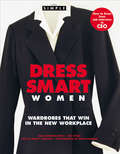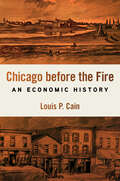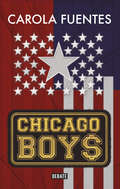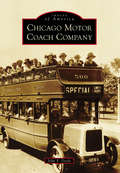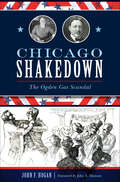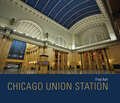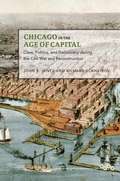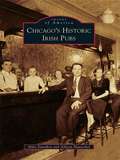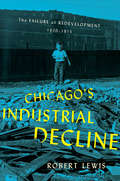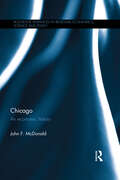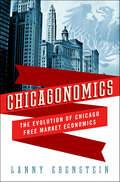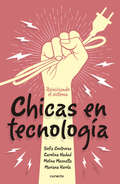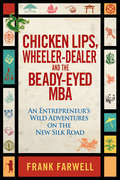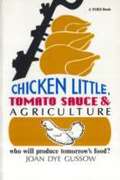- Table View
- List View
Chevron Corp.: Corporate Image Advertising
by John A. QuelchDescribes a series of advertising research studies conducted by Chevron to monitor the effectiveness of its corporate advertising. Specific research approaches covered include the McCollum-Spielman and Communications Techniques. The Vals Typology developed by Stanford Research Institute is used in specifying target markets.
Chewy.com (A)
by Matthew Preble Jeffrey RayportIn late 2013, Ryan Cohen, cofounder and CEO of the fast growing online pet food and pet products retailer Chewy.com, has to make a "bet the company decision"-whether to keep working with Chewy's third-party logistics (3PL) provider to fulfill customer orders, or whether to take this critical function in-house. Cohen worries that the company's 3PL will not be able to serve Chewy's customers as it continues to grow, and reaching scale is essential to making the company's business model work, and to hitting the aggressive growth target that he has set of becoming a $500 million revenue company by 2018. However, some board members are concerned, and have suggested that Cohen slow growth and leave order fulfillment to the 3PL, as Cohen and the executive team are not operations experts; they are customer service experts, and that should be their focus. Cohen sees four possible paths for Chewy: stick with its current 3PL and slow down growth; add another 3PL to the mix to support Chewy as it scales; stay with its current 3PL and build out a fulfillment center in a new market to "test it out"; or fully "insource" order fulfilment, and open a fulfilment center as quickly as possible. Which path should Cohen and Chewy's board choose?
Chia Network: Reimagining Programmable Money
by William A. Sahlman George GonzalezChia Network seeks to develop the leading blockchain by improving upon the technology used by Bitcoin, Ethereum, and other decentralized platforms.
Chiacchierare Senza Sforzo: Come Fare Conversazione Con Chiunque, Dovunque E In Qualsiasi Occasione
by E. Franzoni Andy ArnottChiacchierare senza sforzo Odiate fare conversazione? Vorreste andare a una persona qualsiasi, in qualsiasi momento e luogo, e iniziare a parlare con lei? Beh, non è difficile... Io odiavo chiacchierare, mi ritrovavo a impappinarmi e a sentirmi in imbarazzo, ma invece di accettare le mie pessime abilità sociali come "parte di me", ho deciso di superarle e di diventare un esperto nel chiacchierare. E anche voi potete farlo... In questo libro descrivo tutti i dettagli di quello che ho fatto per superare la mia paura ed incapacità nel fare conversazione, in modo che possiate fare lo stesso anche voi. Potete prendere questo libro, leggerlo tutto ed avere una struttura passo-passo da seguire per poter imparare a chiacchierare. Se seguite questa semplice procedura ed usate le strategie che descrivo, potrete fare conversazione con chiunque, dovunque e in qualsiasi momento. Ho studiato tutto, dagli stimati psicologi agli artisti del rimorchiare, in modo da poter trovare il modo più semplice di superare le mie paure. Tutto in questo libro viene riportato alla sua forma più semplice, e poi viene messo insieme in passi che tutti possano fare. Ciò vuol dire che non dovrete passare ore innumerevoli a fare ricerche, leggere e provare tecniche, perché l'ho fatto io per voi. Dovete solo leggere questo libro. Al suo interno imparerete: - Le strategie più semplici ed applicabili per diventare maestri della conversazione - Come 'aprire' una conversazione senza sforzo, non importa dove vi troviate - Come controllare il vostro linguaggio del corpo per fare in modo che la gente voglia parlare con voi - Come usare la conversazione per andare avanti nella vita - Semplici trucchi psicologici per migliorare istantaneamente il vostro stato d'animo e irradiare sicurezza in voi stessi - Come fare in modo che le altre persone vogliano parlare con voi E molto altro ancora. Ma perché chiacchierare è così importante? Beh, ecco cosa è buffo... La mag
Chiapas: Reconciling Agriculture and Ecology
by Juan Enriquez Ray A. GoldbergChiapas: Reconciling Agriculture and Ecology by Ray A. Goldberg and Juan Enriquez-Cabot
Chiapas: Reconciling Agriculture and Ecology
by Juan Enriquez Ray A. GoldbergThe objective is to reconcile the trade-offs involved in setting an agricultural policy in delicate ecological settings and determine the role business should play in an imperfectly competitive developing region.
Chic Simple Dress Smart Women: Wardrobes That Win in the New Workplace
by Kim Johnson Gross Jeff Stone Kristina Zimbalist David BashawIn a nation recovering from economic turmoil, today's business men and women need every advantage to keep precious jobs and get new and better jobs. In the Chic Simple Dress Smart book, veteran style mavens Kim Johnson Gross and Jeff Stone walk readers through the basics of building a work-appropriate wardrobe that provides a look of confidence and competence, and expresses personal style. Whether it's buying the right blazer for a middle management position, or assembling the most versatile pieces for someone just entering the workforce, these savvy and informative guides provide the straight answers to how people can put their most positive image forward at work.
Chicago Before the Fire: An Economic History
by Louis P. CainAn advantageous location and entrepreneurial passion helped fuel Chicago’s transformation from a fur trading post to a thriving city. Louis P. Cain’s economic history places pre-1871 Chicago within the narrative of national expansion and examines infrastructure, finance, and other areas of city life. Business histories tell the story of fortunes made with essential products like meat and grain. Sketches of titans like William Ogden and Cyrus McCormick reveal how real estate, farm equipment, and other industries became engines of local growth. Cain also details public health improvements that made Lake Michigan safe as a water supply while census data informs a portrait of Chicago’s population and the lives of the free Blacks and Irish immigrants at the bottom of the socioeconomic ladder. Panoramic and up to date, Chicago before the Fire looks at how an intersection of geography, vision, and investment built a great American city.
Chicago Boys
by Carola FuentesLuego del documental: el libro que explica el Chile actual. Este libro, que tuvo su origen en el prestigioso documental dirigido por Carola Fuentes, relata cómo un grupo de jóvenes, a fines de los años cincuenta, partió a Chicago para estudiar economía con un profesor que luego pasaría a la historia: Milton Friedman. Los estudiantes volvieron a Chile, se instalaron en la academia y en la prensa para, luego de circunstancias políticas que jugaron a su favor, instaurar un sistema de economía basada en la libertad absoluta del mercado. Las políticas de shock económico que se aplicaron en Chile a partir de 1975 y que tuvieron sucesivas variaciones tanto en la dictadura militar como en los gobiernos de la Concertación, han moldeado por completo las estructuras fundamentales de la sociedad chilena: la educación, la salud, las pensiones, el trabajo, la cultura, la política y básicamente toda la vida social. No cabe duda que el verdadero legado de Pinochet y de Jaime Guzmán fueron los Chicago Boys. Este libro es una crónica que relata el origen, desarrollo intelectual, ascenso y caída de aquellos economistas que forman parte del imaginario político, intelectual y social. Un grupo con vínculos en el extranjero y con el capital mercantil y financiero chileno. El grupo que creó un modelo social que impera hasta hoy. Los verdaderos padres del neoliberalismo.
Chicago Motor Coach Company (Images of America)
by John F. DoyleChicago Motor Coach Company chronicles an era in Chicago when buses first traversed the city's park district boulevards, including the Magnificent Mile. Streetcars were not allowed on the boulevards; this situation paved the way for the first motor bus operation, Sheridan Road on the North Side, in 1917. By 1922, John D. Hertz would purchase the Sheridan Road line and secure franchises to operate over the boulevards on the South and West Sides. The Chicago Motor Coach Company was now born, along with the bus-building industry. From a Hertz plant in Chicago, it would become General Motors Truck and Coach Division at Pontiac, Michigan, the largest producer of transit buses in the world. In 1952, the Chicago Transit Authority (CTA) would purchase the Chicago Motor Coach Company.
Chicago Shakedown: The Ogden Gas Scandal
by John F. HoganThe Ogden Gas Affair represented the biggest political scandal of Chicago's first sixty years. Mayor John P. Hopkins and Democratic Party boss Roger Sullivan conspired with ten other insiders to form a dummy corporation to blackmail Peoples Gas Company. The scam poured money into the coffers of beneficiaries who were never prosecuted, including the governor of Illinois, John P. Altgeld. As their lengthy swindle ran its course, Hopkins and Sullivan rubbed elbows with the most notorious grafters of the robber baron era, including Charles Yerkes and "Big Bill" Thompson. Author John Hogan follows the money in a scheme that became a template for the enrichment of the connected at the expense of the citizenry.
Chicago Union Station (Railroads Past and Present)
by Fred AshA history of the Midwestern transportation hub and its impact on the city and the region, plus stunning photographs of the station’s architecture.More than a century before airlines placed it at the center of their systems, Chicago was already the nation’s transportation hub—from Union Station, passengers could reach major cities on the Atlantic, Pacific and Gulf coasts as well as countless points in between.Chicago’s history is tightly linked to its railroads. Railroad historian Fred Ash begins in the mid-1800s, when Chicago dominated Midwest trade and was referred to as the “Railroad Capital of the World.” During this period, swings in the political climate significantly modified the relationship between the local government and its largest landholders, the railroads. From here, Ash highlights competition at the turn of the twentieth century between railroad companies that greatly influenced Chicago’s urban landscape. Profiling the fascinating stories of businessmen, politicians, workers, and immigrants whose everyday lives were affected by the bustling transportation hub, Ash documents the impact Union Station had on the growing city and the entire Midwest.Featuring more than one hundred photographs of the famous beaux art architecture, Chicago Union Station is a beautifully illustrated tribute to one of America’s overlooked treasures.“The book includes more than 100 illustrations, a quarter of which are in color—but the real value is in author Ash’s narrative; he’s devoted decades to the study of terminals in the Railroad Capital, and it shows in this marvelous work.” —Classic Trains“The station’s history is thoughtfully revealed alongside concurrent economic and political events unfolding in Chicago at given points in time, thus providing the reader with a deeper understanding of why certain station milestones occurred when they did and the way they did.” —The Michigan Railfan
Chicago in the Age of Capital: Class, Politics, and Democracy during the Civil War and Reconstruction
by Richard Schneirov John B. JentzIn this sweeping interpretive history of mid-nineteenth-century Chicago, historians John B. Jentz and Richard Schneirov boldly trace the evolution of a modern social order. Combining a mastery of historical and political detail with a sophisticated theoretical frame, Jentz and Schneirov examine the dramatic capitalist transition in Chicago during the critical decades from the 1850s through the 1870s, a period that saw the rise of a permanent wage worker class and the formation of an industrial upper class. Jentz and Schneirov demonstrate how a new political economy, based on wage labor and capital accumulation in manufacturing, superseded an older mercantile economy that relied on speculative trading and artisan production. The city's leading business interests were unable to stabilize their new system without the participation of the new working class, a German and Irish ethnic mix that included radical ideas transplanted from Europe. Jentz and Schneirov examine how debates over slave labor were transformed into debates over free labor as the city's wage-earning working class developed a distinctive culture and politics. The new social movements that arose in this era--labor, socialism, urban populism, businessmen's municipal reform, Protestant revivalism, and women's activism--constituted the substance of a new post-bellum democratic politics that took shape in the 1860s and '70s. When the Depression of 1873 brought increased crime and financial panic, Chicago's new upper class developed municipal reform in an attempt to reassert its leadership. Setting local detail against a national canvas of partisan ideology and the seismic structural shifts of Reconstruction, Chicago in the Age of Capital vividly depicts the upheavals integral to building capitalism.
Chicago's Historic Irish Pubs (Images of America)
by Allison Hantschel Mike DanaheyFrom dancing at Hanley's House of Happiness to raising pints at Kelly's Pub on St. Patrick's Day, the history of the Irish community in Chicago is told through stories of its gathering places. Families are drawn to the pub after Sunday church, in the midst of sporting events, following funerals, and during weddings. In good times and bad, the pub has been a source of comfort, instruction, and joy--a constant in a changing world. Based on interviews with tavern owners, musicians, bartenders, and scholars, Chicago's Historic Irish Pubs explores the way the Irish pub defines its block, its neighborhood, and its city.
Chicago's Industrial Decline: The Failure of Redevelopment, 1920–1975
by Robert LewisIn Chicago's Industrial Decline Robert Lewis charts the city's decline since the 1920s and describes the early development of Chicago's famed (and reviled) growth machine. Beginning in the 1940s and led by local politicians, downtown business interest, financial institutions, and real estate groups, place-dependent organizations in Chicago implemented several industrial renewal initiatives with the dual purpose of stopping factory closings and attracting new firms in order to turn blighted property into modern industrial sites. At the same time, a more powerful coalition sought to adapt the urban fabric to appeal to middle-class consumption and residential living. As Lewis shows, the two aims were never well integrated, and the result was on-going disinvestment and the inexorable decline of Chicago's industrial space.By the 1950s, Lewis argues, it was evident that the early incarnation of the growth machine had failed to maintain Chicago's economic center in industry. Although larger economic and social forces—specifically, competition for business and for residential development from the suburbs in the Chicagoland region and across the whole United States—played a role in the city's industrial decline, Lewis stresses the deep incoherence of post-WWII economic policy and urban planning that hoped to square the circle by supporting both heavy industry and middle- to upper-class amenities in downtown Chicago.
Chicago: An economic history (Routledge Advances in Regional Economics, Science and Policy)
by John F. McDonaldChicago went from nothing in 1830 to become the second-largest city in the nation in 1900, while the Midwest developed to become one of the world’s foremost urban areas. This book is an economic history of the Chicago metropolitan area from the 1820s to the present. It examines the city in its Midwestern region and compares it to the other major cities of the North. This book uses theories of the economics of location and other economic models to explain much of Chicago’s history. Chicago maintained its status as the second-largest city through the first decades of the 20th century, but rapid growth shifted to the Sunbelt following World War II. Since the 1950s the city’s history can be divided into four distinct periods; growth with suburbanization (1950-1970), absence of growth, continued suburbanization, and central city crisis (1970-1990), rebound in the 1990s, and financial crisis and deep recession after 2000. Through it all Chicago has maintained its position as the economic capital of the Midwest. The book is a synthesis of available literature and public data, and stands as an example of using economics to understand much of the history of Chicago. This book is intended for the college classroom, urban scholars, and for those interested in the history of one of world’s foremost urban areas.
Chicagonomics: The Evolution of Chicago Free Market Economics
by Lanny EbensteinChicagonomics explores the history and development of classical liberalism as taught and explored at the University of Chicago. Ebenstein's tenth book in the history of economic and political thought, it deals specifically in the area of classical liberalism, examining the ideas of Friedrich Hayek and Milton Friedman, and is the first comprehensive history of economics at the University of Chicago from the founding of the University in 1892 until the present. The reader will learn why Chicago had such influence, to what extent different schools of thought in economics existed at Chicago, the Chicago tradition, vision, and what Chicago economic perspectives have to say about current economic and social circumstances.Ebenstein enlightens the personal and intellectual relationships among leading figures in economics at the University of Chicago, including Jacob Viner, Frank Knight, Henry Simons, Milton Friedman, George Stigler, Aaron Director, and Friedrich Hayek. He recasts classical liberal thought from Adam Smith to the present.
Chicas en Tecnología®: Reiniciando el sistema
by Mariana Varela Carolina Hadad Sofía ContrerasLa tecnología tiene un papel determinante en lo cotidiano: el trabajo, la educación y la vida social. Pero es un área desigual para las mujeres. Este libro da cuenta de la brecha de género en tecnología y de la invisibilización de las pioneras y las líderes, pero es también una invitación a reiniciar el sistema, a que las mujeres consideren a la tecnología como una aliada para mejorar el mundo. La tecnología tiene un papel determinante en lo cotidiano: el trabajo, la educación y la vida social. Pero es un área profundamente desigual para las mujeres. La disparidad comienza en la infancia -a las niñas les regalan una cocinita y a los niños, videojuegos- y continúa durante la escolarización, la formación profesional, la capacitación, en el ambiente laboral o cuando deciden emprender. Las mujeres chocan constantemente con la estigmatización, la mirada estereotipada, la brecha salarial, discriminación y violencia. Cuando en 2015 Sofía Contreras, Carolina Hadad, Melina Masnatta y Mariana Varela crearon la organización Chicas en Tecnología® con el objetivo de achicar la brecha de género en ese campo, el feminismo no tenía la fuerza de hoy en la escena pública, y si bien se ganaron derechos, aún falta mucho. Con datos, fuentes, investigaciones, análisis y la experiencia de las autoras, este libro evidencia las barreras que las mujeres enfrentan en el ambiente tecnológico, pero además propone cambios e ideas en educación, liderazgo, emprendedorismo, mentoreo. Rescata de la invisibilización a las pioneras y demuestra por qué es fundamental que haya cada vez más líderes mujeres y multiplicidad de voces. Chicas en Tecnología® es una invitación a reiniciar el sistema, a que las mujeres consideren a la tecnología como una aliada para mejorar el mundo.
Chicken Lips, Wheeler-Dealer, and The Beady-Eyed M.B.A.
by Frank FarwellOne man's worldwide entrepreneurial adventure. . . and how to follow in his footsteps Part memoir, part practical guide for any budding entrepreneur, Chicken Lips, Wheeler-Dealer and the Beady-Eyed M. B. A. is the story of how one man abandoned a cushy publishing job in Manhattan to pursue his dream of working for himself. Spanning eleven years, the book tells the sometimes moving, sometimes funny, and always inspiring story of Frank Farwell, who rediscovered a forgotten product from China and cashed in on a readily defined American market niche. A fascinating look at the transitional years of modern China, the book is packed with helpful information for anyone keen to leave well-paid tedium for the Wild West of self-employment. As the interest in self-employment rises, Chicken Lips, Wheeler-Dealer, and the Beady-Eyed M. B. A. fills an important niche. Covering the successes and failures that mark the path of the committed entrepreneur, the book entertains and instructs using concrete, real-life examples that clearly illustrate the dos and don'ts of running your own business. A non-fiction look at the world of self-employment that uses a real-life story to illustrate successes and pitfalls Includes a "Lessons Learned" appendix that succinctly explain the most important takeaways for starting your own business A compelling insight into entrepreneurship that spans continents The story of a tenderfoot company and its neophyte boss who maneuvers his way in and out of trouble to ultimately build a business that is still thriving today, Chicken Lips, Wheeler-Dealer, and the Beady-Eyed M. B. A. is a fascinating, informative look at entrepreneurship in the twenty-first century.
Chicken Little, Tomato Sauce And Agriculture: Who Will Produce Tomorrow's Food
by Joan Dye GussowJoan Gussow is considered a pioneer in nutrition and local/organic food. Although written in 1991, this book is very relevant to our current agricultural issues. She is one, among a group of writers and activists who have been trying to tell everyone these things all along: it seems that now they are just starting to reach the mainstream audience. Out of her three major books (this one first, then Confessions of a Suburban Homesteader, then Growing, Older...all written about a decade apart), this one is the least 'personal', with a more academic feel.
Chicken Republic
by Natalie Kindred Jose B. AlvarezDeji Akinyanju, founder of Nigerian fast-food chain Chicken Republic, and Ayo Oduntan, founder of an integrated Nigerian poultry operation (Amo Byng Group), are among a growing cadre of skilled food-industry entrepreneurs for whom the opportunities to serve the Nigerian market-a population of over 170 million, including a large and growing middle class-outweigh the challenges of operating there. And indeed, as embodied by Nigeria's status as a net food importer despite having 80 million hectares of arable land, the challenges are considerable. Animal feed is excessively expensive, driving up poultry production costs and limiting production volumes; illegal poultry imports pose food safety threats while undercutting prices of domestic product; corruption is rampant; debt is exorbitantly expensive; commercial real estate is sparse; and electricity is unreliable. Yet, Nigeria has all the natural blessings to be an agricultural powerhouse competitive on an international scale. And it has the large, ambitious population needed to drive its development, both as workers and consumers. Akinyanju and Oduntan believe many of the issues constraining Nigeria's poultry sector can be alleviated with relatively simple solutions-and that doing so can open tremendous growth opportunities for their businesses and the country as a whole. Set in October 2015, this case provides a detailed look at Nigeria's poultry value chain and the complexities of modernizing a traditional and largely informal industry. It also presents an inspiring story of determined entrepreneurs succeeding against tough odds. Finally, for students whose conception of Nigeria is all too often reduced to simplistic headlines, this case offers a more nuanced look into the complexities, potential, and aspirations of what may be one of this century's most dynamic and important economies.


